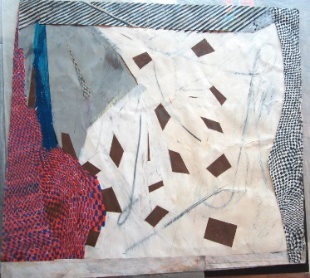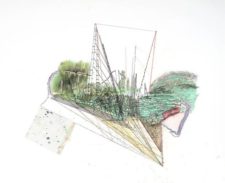(see also Tanner – Three Journeys a Night)

Joan Tanner
American, 1935-
Banded Location, 1970
Chalk, graphite, oil paint fragments, frisket, metallic paint, masking tape
22½ x 28½ in.
Collection of the artist


Tanner - donotellmewhereibelong #19
COMMENTS
The process of drawing is an excursion through ideas, a means by which an artist can test out theories and apply one surface to another, without the commitment of three-dimensional materials. Joan Tanner, whose large-scale installations are like a chess game played with limitless pieces, experiments in equally compelling ways in her drawings.
In the same way that stories are made of words that we recognize, a sculpture is made of materials that can come with meanings. When those materials are themselves complete objects, the reading of the piece is hemmed in by its components’ known uses in society. An artist can put these parts together in challenging or ironic ways, but she cannot completely ignore prior functions.
A drawing, however, is more slippery. Line can merely suggest meanings and not have to contain them. Like the shadows in Plato’s cave, a line holds whatever meaning the beholder assigns it. One calls it a live creature, another, a finger puppet. Tanner’s drawings make ample use of the medium’s ambiguities, suggesting a wide range of possibilities but never constraining us to a single reading.
Ambiguity of scale is a major tool in Tanner’s box. Donotellmewhereibelong #32 (2014), for example, is an accumulation of fine lines on a smudge of blue chalk in the midst of a white page. The lines coalesce into a central form that could be as large as a rock hollow in the side of a cliff or as small as a side of fleshy tissues under a microscope. Never fully divorced from the flat surface, these marks dissolve into a crisscross pattern on the form’s periphery.
Endofred #3 introduces ambiguity of viewpoint as a modus operandi. Thick red oil stick splotches cover undulating lines that resemble winding rivers viewed from above. Envisioned in profile, this same set of marks is a grotesque rooster hopping on one foot, or a cloud of debris kicked up by a small tornado. These very different readings coexist within a remarkably cohesive composition.
Tanner’s marks often straddle the line between the mimetic and the schematic. She freely mixes lines that suggest form and surface with others that resemble an architect’s plans. Donotellmewhereibelong #19 (2014), for example, contains a thicket of ruled graphite lines that converge in the manner of the orthogonal foci of perspective diagrams. Covered with smudges of turquoise and green, however, these triangular configurations also suggest a bay full of sailboats and waves. Tilting toward the side of an otherwise white page, this entire nautical configuration appears to drift into outer space.
The frequent appearance of a lonely clump of matter in the midst of a void lends a kind of alien spaceship aspect to the work. However, the drawings’ fierce openness keeps them out of the sci-fi illustration territory of, say, Roger Dean’s Yes album cover art. At once flat and pictorial, and seen simultaneously in plan and elevation views, these drawings have too many complications to be illustrative.
The openness of Tanner’s graphic work relates to the working process she uses for her sculptures and installations. An online video of her assembly of the piece On Tenderhooks (2006) shows a flurry of activity, with assistants bringing objects into the gallery, rolling them around, nailing them together, taking them apart, then removing them altogether. Along the way, Tanner traces all possibilities inherent in the form, in the same way that we as viewers run through many alternative readings as we engage with her drawings. The topsy-turvy orientation of this exhibition’s various pieces is equivalent to the drawings’ ambiguous scale and viewpoint, and the choice to omit elements resonates with the drawings’ vast voids. Tanner demonstrates a comparable level of persistence in the making of her three-dimensional work and her drawings, albeit of a different kind. The one involves hitting the same path repeatedly until she arrives at her destination; the other, hitting every path until she finds the right one. It is not surprising, therefore, that her drawings encompass a level of openness impossible in the more resolutely determined works.
http://www.artcritical.com/2016/01/19/edward-epstein-on-joan-tanner/
SBMA CURATORIAL LABELS
Originally from Indianapolis, Joan Tanner has lived and worked in Santa Barbara since the 1960s. Her fifty-year career is marked by a practice that remains genuinely inventive, and involves painting, drawing, sculpture, photography, and installation. Working with unusual materials such as items used in common construction, fragments of oil paint, scraps of leftover canvas, and other odds and ends that she saves and reutilizes, she transforms such everyday objects in unexpected ways.
These three works on paper, created out of various media that has been intuitively layered and collaged together, embody a sense of restlessness that demonstrates the artist’s ongoing interest in pushing boundaries. 9 Spaces by 10, incorporating wire and folded paper, takes drawing into the third dimension and calls to mind her sculptures, which range in size from the tiny to room-sized installations. Working in a distinctive mode of abstraction, Tanner’s organic forms generate tensions, evoke nostalgia and suggest sensations.
- Summer Nocturne, 2018
